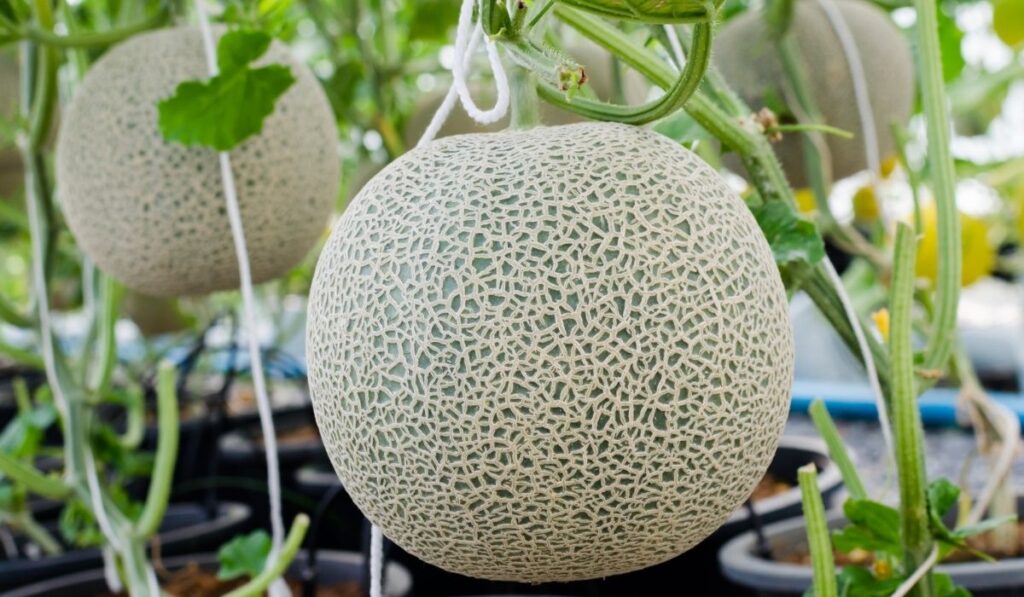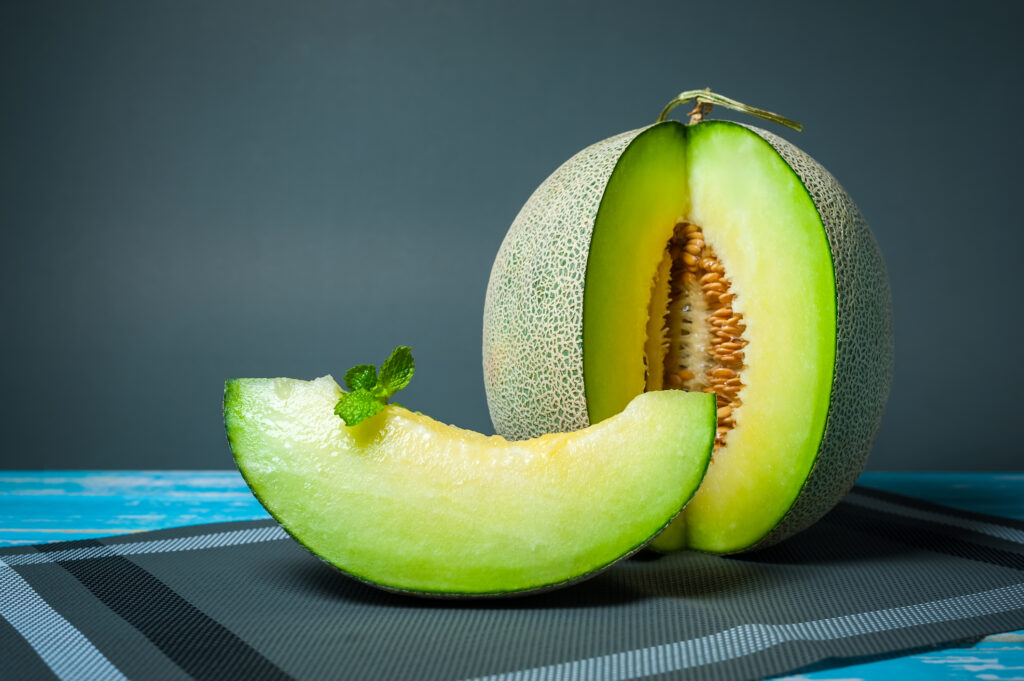Honeydew melon is an excellent, sweet treat that can be enjoyed all year round. However, you might have a mushy experience if you aren’t sure what to look for or don’t know how to tell if the melon is ripe.
The best time to eat honeydew is between June and October in most areas. You can tell if the melon is ripe by smelling the stem for a sweet and fruity aroma. The skin should also feel firm but give slightly to pressure. Avoid melons with green veins, dark spots, or bruises on the exterior.
Honeydew is a great addition to your diet, as an excellent low-calorie treat that provides many nutrients. Here’s everything you need to know about the honeydew season, how to tell if a melon is ripe, and the associated health benefits.
Where Is Honeydew Grown?

The exact origins of honeydew, sometimes called honeymellon, remain unknown. However, the melon is believed to come from Algeria, Southern France, Spain, the Middle East, and western Asia.
In ancient times, honeydew was cultivated in the Middle East, considered to be a sacred delicacy by the Egyptians thanks to its sweet and juicy flavor.
Honeydew didn’t appear in Europe until late in the 15th century, and honeydew seeds are thought to have been brought to the United States by Christopher Columbus. Today, honeydew is cultivated in Mexico, California, Arizona, and other parts of the American southwest.
When Is Honeydew in Season?
Honeydew sometimes has the reputation of having a sandy or mushy texture. Fortunately, you can find the perfect melon and have a wonderful experience if you shop for honeydew during the right seasons.
Honeydew is available all year round but is best from late summer to early fall. In the northern hemisphere, honeydew peak seasons are between June and October. You can purchase high-quality honeydew as early as May and as late as November in some locations.
If you really want some honeydew when it’s not in season, be sure to check out dried fruit mix options like Anna and Sarah Tropical Dried Fruit Mix (on Amazon) which include Honeydew, and consider Honeydew Powder (also on Amazon) which can be added to smoothies or yogurt.
How Do You Know When Honeydew Melon Is Ripe?

An unripe honeydew can result in mushy, unsatisfactory experience. Because these melons are available all year round, it’s crucial to know how to tell when one is ripe. Like with other large melons, it can be somewhat tricky to pick a good honeydew melon if you don’t know what to look for.
Unlike other melons, honeydew melons won’t become ripe if they’re picked too early. But assuming the honeydew in your local grocery store is fully mature, you’re sure to find a good one based on smell.
Ripe honeydew gives off a lightly floral and sweet fruity aroma from the stem. Sweeter melons might have more aromatic scents. On the opposite side of the stem, the melon should feel soft and almost springy with a little bounce back.
You can also check the skin. The skin should appear waxy, with a creamy and uniform color. The outside should feel firm but give slightly to pressure. If it feels too dense or like a rock, it needs a bit more time. Look out for and avoid any green veins, soft spots, or bruises, as they’re indicators of unripe honeydew.
Finally, you can give your melon a shake to see if it’s ripe. The seeds of a honeydew become loose as the melon ripens. If you can hear faint rattling sounds when you shake it, the melon is most likely ready to eat.
Is Honeydew Good for You?
Honeydew not only tastes great, but it’s also great for your health. One of the greatest advantages of this melon is its diverse nutrient profile. Honeydew has high levels of vitamin C, fiber, and antioxidants — and it’s low in calories. Here are some other benefits to this melon.
May Improve Bone Health
Honeydew contains several key nutrients that are vital to bone health, including folate and vitamin K. Adding the melon to your diet may help strengthen your bones and prevent conditions like osteoporosis.
The folate found in honeydew can help break down homocysteine, which can weaken bone mineral density in high levels. Vitamin K can help the calcium ions in your bones bond with necessary proteins known as osteocalcin.
Furthermore, one serving of honeydew contains around 4% of your daily magnesium intake. Magnesium is required for the cells that are responsible for building and breaking down bone tissue.
May Improve Skin Health
Honeydew melon contains high amounts of vitamin C, a powerful antioxidant that can aid skin health. In fact, one half-cup serving of this fruit has around a quarter of your daily recommended vitamin C intake.
Research has shown that vitamin C can help protect skin against sun damage and help the production of collagen. Collagen is a major structural protein that’s crucial for repairing and maintaining skin. Adding honeydew to your diet may help you get enough vitamin C, protecting and nourishing your skin in the process.
May Help Decrease Blood Pressure
Broadly speaking, diets high in fruits and vegetables are linked with a decreased risk of high blood pressure and heart disease. On top of that, low-sodium diets with the correct potassium intake can have a positive impact on blood pressure regulation.
Because honeydew melon is low-sodium and rich in potassium, it may help you attain healthy blood pressure levels. A 1-cup serving of honeydew can provide you with 12% of your daily recommended intake of potassium.
Rich in Electrolytes and Water
Honeydew is around 90% water and contains numerous electrolytes. Electrolytes such as potassium, magnesium, sodium, and calcium are crucial for proper hydration.
With the combination of water, nutrients, and electrolytes, honeydew is an excellent choice after a workout, during illness, or to stay hydrated throughout the day.
May Boost Your Immune System
Honeydew melon is chock full of vitamin C, which is crucial for supporting healthy immune function. Your immune system is complicated and needs a variety of nutrients to work properly.
Research has linked adequate intake of dietary vitamin C to preventing and treating respiratory and systemic infections such as pneumonia and the common cold. This means adding a bit of honeydew to your diet could help keep you from getting sick.
One cup of honeydew melon offers over half of the recommended daily value for vitamin C. Try adding the fruit into your diet during the winter or cold season.
May Promote Proper Digestion
Honeydew also contains fiber. Fiber is a nutrient that is renowned for increasing digestive health. Proper levels of dietary fiber can slow blood sugar response, promote bowel regularity, and increase the growth of healthy gut bacteria.
Though other fruits contain fiber, honeydew still offers around 5% of your daily intake from a single cup. Many people recommend honeydew for individuals adding or reintroducing fiber into their diet, as it might be tolerated better than high-fiber options.
May Support Vision and Eye Health
Honeydew might also support vision and eye health due to two powerful antioxidants: lutein and zeaxanthin. These carotenoid compounds are produced by plants and give fruits and vegetables their color.
Lutein and zeaxanthin are well known for promoting eye health and stopping the development of age-related vision issues. Research is showing that regularly eating foods with these antioxidants may support healthy eye function in the long run.
